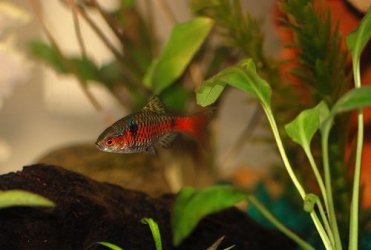WhistlingBadger
Professional Cat Herder
Retired Moderator ⚒️
Tank of the Month 🏆
Fish of the Month 🌟
- Joined
- Dec 18, 2011
- Messages
- 7,014
- Reaction score
- 13,034
- Location
- Where the deer and the antelope play
So here's the deal. I've long wanted to keep odessa barbs (Pethia padamya) because they're reputed to be very peaceful, and the coloring of the males is amazing. I finally have a biotope going to that they would fit in, so I ordered six from TWS.
Two troubles: I got a group of four females and two males. The females are rather non-descript and I'd like more males. But the bigger problem is the agression level. These fish are CONSTANTLY chasing each other, so much that the tank isn't even fun to watch.
Setup: A 30 gallon tank, filled to only 12" deep. So it functions as a 20 long, 30" long by 12" wide by 12" high. A whole bunch of rocks and driftwood; moderate to fast current; water temp around 70 F most of the time (room temperature). Tank simulates a shallow, fast-flowing hillstream. Tankmates are choprae danios, hillstream loaches, and some tiny stone loaches. No aggression observed in other species.
I suspect the problem might be lack of space, as there is a LOT of hardscape in this tank. (Click the link in my signature to get a look at it) But it's also possible that my numbers are too low; most websites say to get at least five, but shoaling species tend to like larger groups.
I would love to get more males, if more members of the shoal would alleviate the problem. But if lack of space is the problem, then perhaps I need to get rid of some, or even rehome the entire group and get more chopraes instead. (then there's the issue of how in the world I'm going to catch these things, but that's another discussion)
Things aren't OK right now, but I certainly don't want to make it worse. Anybody have experience with this species? What should I do?
Two troubles: I got a group of four females and two males. The females are rather non-descript and I'd like more males. But the bigger problem is the agression level. These fish are CONSTANTLY chasing each other, so much that the tank isn't even fun to watch.
Setup: A 30 gallon tank, filled to only 12" deep. So it functions as a 20 long, 30" long by 12" wide by 12" high. A whole bunch of rocks and driftwood; moderate to fast current; water temp around 70 F most of the time (room temperature). Tank simulates a shallow, fast-flowing hillstream. Tankmates are choprae danios, hillstream loaches, and some tiny stone loaches. No aggression observed in other species.
I suspect the problem might be lack of space, as there is a LOT of hardscape in this tank. (Click the link in my signature to get a look at it) But it's also possible that my numbers are too low; most websites say to get at least five, but shoaling species tend to like larger groups.
I would love to get more males, if more members of the shoal would alleviate the problem. But if lack of space is the problem, then perhaps I need to get rid of some, or even rehome the entire group and get more chopraes instead. (then there's the issue of how in the world I'm going to catch these things, but that's another discussion)
Things aren't OK right now, but I certainly don't want to make it worse. Anybody have experience with this species? What should I do?



